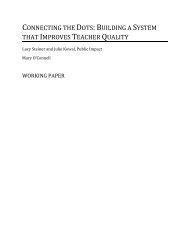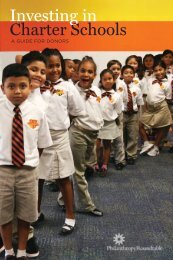Using Competency-Based Evaluation to Drive Teacher Excellence
Using Competency-Based Evaluation to Drive Teacher Excellence
Using Competency-Based Evaluation to Drive Teacher Excellence
You also want an ePaper? Increase the reach of your titles
YUMPU automatically turns print PDFs into web optimized ePapers that Google loves.
figure 2. The Ethnic and Religious Diversity of Singapore’s People<br />
Ethnicity<br />
Other 1%<br />
Catholic 5%<br />
Religion<br />
Malay 14%<br />
Indian<br />
8%<br />
Chinese 77%<br />
Other<br />
1%<br />
None 15%<br />
Christian 10%<br />
Buddhist 42%<br />
Hindu<br />
4%<br />
Taoist<br />
8%<br />
Muslim 15%<br />
Source: Central Intelligence Agency. World Factbook, East and Southeast Asia: Singapore. Retrieved April 2, 2010 from<br />
https://www.cia.gov/library/publications/the-world-factbook/geos/sn.html<br />
English at home.15 In addition, as in the United<br />
States, Singapore has wide economic diversity, as<br />
illustrated by the country’s Gini coefficient, a common<br />
measure of inequality in the distribution of<br />
family income within a country. Values range from<br />
0 <strong>to</strong> 1, with lower values representing greater equality.<br />
Singapore’s Gini coefficient was 0.481 in 2008, making<br />
it the 30th most unequal country on a list of<br />
134 countries, above even the United States, which<br />
was 43rd.16<br />
Ninety-eight percent of Singapore’s<br />
sixth-grade students pass exams more<br />
rigorous than the eighth-grade NAEP<br />
mathematics test in the U.S. — nearly<br />
triple the percentage of proficient<br />
eighth-grade U.S. students.<br />
However, what makes Singapore most useful<br />
as an example <strong>to</strong> U.S. educa<strong>to</strong>rs and policymakers<br />
is that Singaporean students consistently excel on<br />
international exams. For the past five years, Singapore<br />
has ranked among the <strong>to</strong>p four countries in the<br />
world on the Trends in International Mathematics<br />
and Science Study (TIMSS) science and math tests<br />
and the Progress in International Reading Literacy<br />
Study (PIRLS) reading test (see Table 1).17 National<br />
assessments tell a similar s<strong>to</strong>ry. Ninety-eight percent<br />
of Singaporean students passed their sixth-grade<br />
“leaving” exam in 2009.18 U.S. scholars comparing<br />
this exam <strong>to</strong> the National Assessment of Educational<br />
Progress in the U.S. (NAEP) have concluded that<br />
the Singaporean sixth-grade exam in mathematics is<br />
more rigorous than the eighth-grade NAEP test.19<br />
In comparison, 31 percent of U.S. students tested<br />
proficient in reading on the eighth-grade NAEP test,<br />
while 34 percent were proficient in math and 29 percent<br />
in science, according <strong>to</strong> the most recent results<br />
6 | lessons from singapore www.opportunityculture.org





